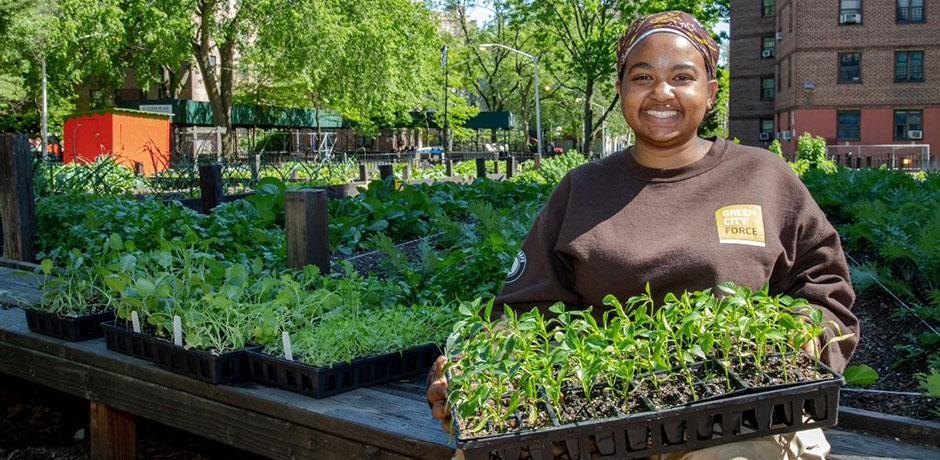The Buzz on City Blooming
The Buzz on City Blooming
Blog Article
The 2-Minute Rule for City Blooming
Table of Contents4 Simple Techniques For City BloomingThe Buzz on City BloomingNot known Facts About City BloomingSee This Report on City BloomingNot known Facts About City Blooming
Intrigued in expanding food for sale in the City of Chicago? Below is a list of regularly asked inquiries relating to the guidelines and guidelines that farmers ought to consider when planning a metropolitan farming job.
The zoning amendment does not customize any kind of various other codes handling composting, structure authorizations, buying or leasing City possessed building, organization licenses or environmental contamination. There are existing codes that control these problems and they continue to be in full effect and may be suitable to your task. Area gardens are generally owned or handled by public entities, public companies or community-based companies and maintained by volunteers.
Urban farms grow food that is planned to be offered, either on a nonprofit or for-profit basis. As a result of their industrial function, city farms call for a company certificate. Yes. A neighborhood yard is allowed to market surplus create that was grown on site if the sales are accessory or subservient to the yard's primary function defined over.
How City Blooming can Save You Time, Stress, and Money.
The amount of garden compost product can not surpass 25 cubic backyards at any type of provided time according to the criteria in 7-28-715 of the City's Municipal Code. Due to the fact that the soil at many new yard sites requires changing, compost, soil, wood chips, or various other products can be obtained to create or enhance the growing space.

If a building authorization is required then the hoophouse will be taken into consideration an accessory structure. You can discover even more about the building permit needs by getting in touch with the Department of Structures. The 25,000-square-foot size restriction is planned to avoid a solitary neighborhood garden from dominating an offered block or diminishing the block's existing household or commercial personality.
The restriction does not use to yards located in Public Open Room (POS) districts. Can there be greater than one neighborhood yard that is 25,000 square feet on a single block? Yes. The size restriction relates to individual yards, not to individual blocks. No. Secure fencing is not required, nonetheless, yards that have big auto parking locations might be needed to mount fence or various other landscaping functions.
Some Known Incorrect Statements About City Blooming
B1 & B2 areas call for that all commercial usage activities be conducted indoors. R areas limit business task. The regulations mirror the purpose and intent of the Zoning Code. Is secure fencing required for urban farms? Yes. Fencings may be called for, in addition to landscape design and testing, for specific car park locations and outside work or storage space areas depending on location and the certain activity happening.
Urban farms need building licenses and zoning approvals prior to building and construction (urban gardening). Other forms of city testimonial may be called for depending on certain frameworks, activities, size, landscape design, licensing, public heath and stormwater monitoring concerns.
The Division of Service Matters and Consumer Defense can assist figure out the certain type of organization license that's called for. Off street car parking is required for a lot of commercial tasks in Chicago. The needed number of vehicle parking rooms is based on the number of employees working on site and not the square video footage of the expanding area.
The Best Guide To City Blooming

Yes. An urban ranch can market garden compost product generated on website, however, the operation has to abide by the guidelines in 7-28-715 of the Chicago Municipal Code. Yes. Aquaponic systems are allowed inside on metropolitan ranches in many zoning districts. Nevertheless, a zoning testimonial and building permit is needed in order to install structures or systems and a service certificate is called for as defined above.
Up to five hives or swarms of honey bees might be maintained as an accessory use. Beekeepers have to register with the Illinois Division of Agriculture. To learn more concerning the recommended zoning amendment you may contact the Division of Real Estate and Economic Growth, Bureau of Planning and Zoning at 312.744.8563.
, which takes place in rural areas at the side of suburban areas.
Indicators on City Blooming You Should Know
It can include a motion of natural cultivators, "foodies" and "locavores", that seek to form social media networks based on a common values of nature and community holism. These networks can establish using formal institutional assistance, becoming integrated into neighborhood community preparation as a "transition community" motion for lasting metropolitan growth.
The more straight access to fresh vegetable, fruit, and meat items that may be know via city agriculture can boost food safety and security and food safety and security while reducing food miles, resulting in reduced greenhouse gas emissions, therefore adding to environment adjustment reduction. A few of the very first evidence of city farming comes from Mesopotamia.
Report this page